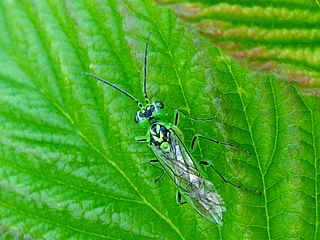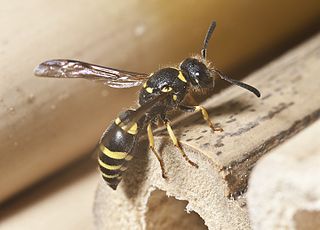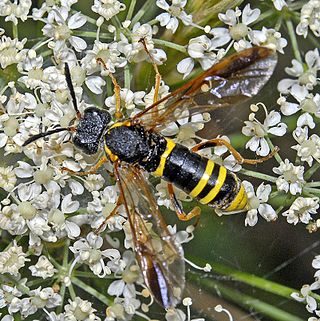
Hymenoptera is a large order of insects, comprising the sawflies, wasps, bees, and ants. Over 150,000 living species of Hymenoptera have been described, in addition to over 2,000 extinct ones. Many of the species are parasitic. Females typically have a special ovipositor for inserting eggs into hosts or places that are otherwise inaccessible. This ovipositor is often modified into a stinger. The young develop through holometabolism —that is, they have a wormlike larval stage and an inactive pupal stage before they mature.

Caterpillars are the larval stage of members of the order Lepidoptera.

Sawflies are the insects of the suborder Symphyta within the order Hymenoptera, alongside ants, bees, and wasps. The common name comes from the saw-like appearance of the ovipositor, which the females use to cut into the plants where they lay their eggs. The name is associated especially with the Tenthredinoidea, by far the largest superfamily in the suborder, with about 7,000 known species; in the entire suborder, there are 8,000 described species in more than 800 genera. Symphyta is paraphyletic, consisting of several basal groups within the order Hymenoptera, each one rooted inside the previous group, ending with the Apocrita which are not sawflies.

The green hairstreak is a small butterfly in the family Lycaenidae.
The spitfire sawfly is a hymenopteran insect found in Australia. It is up to 22 mm long, has two pairs of wings, with a wingspan up to 40 mm, and its wings are honey colored. Its larvae are up to 80 mm long and somewhat resemble a caterpillar.

Volucella pellucens, the pellucid fly, is a hoverfly.

Macrothylacia rubi, the fox moth, is a lepidopteran belonging to the family Lasiocampidae. It was first described by Carl Linnaeus in his 1758 10th edition of Systema Naturae.

Pennisetia hylaeiformis, the raspberry clearwing, is a moth of the family Sesiidae.

Brenthis daphne, the marbled fritillary, is a butterfly of the family Nymphalidae.

Brenthis ino, the lesser marbled fritillary, is a butterfly of the family Nymphalidae.

Arge ochropus, the rose sawfly, is a species belonging to the family Argidae subfamily Arginae.

The dark bush-cricket is a flightless species of European bush-cricket; it is the type species of its genus with no subspecies.

Arge melanochroa is a species of the family Argidae, subfamily Arginae.

Rhogogaster chlorosoma is a species of sawflies in the family Tenthredinidae.

Ancistrocerus nigricornis is a species of potter wasp.

Tenthredo vespa is a sawfly species belonging to the family Tenthredinidae.
Hoplocampa testudinea, the apple sawfly or European apple sawfly, is a species of sawfly in the family Tenthredinidae. It is native to Europe but has been accidentally introduced into North America where it became invasive. The larvae feed inside the developing fruits of the apple tree.

Nematus oligospilus, commonly known as the willow sawfly, is a species of sawfly in the family Tenthredinidae. Native to central and northern Europe and Asia, it was first recorded in South America in the 1980s and New Zealand in 1997, and has also been introduced to Australia, South Africa and Lesotho. Its larvae feed on the leaves of various species of willow.

Neodiprion lecontei is a species of sawfly in the family Diprionidae native to eastern North America, commonly known as the red-headed pine sawfly or Leconte's sawfly. The larvae feed on the foliage of many species of native and imported pines. This species was named after John Lawrence LeConte, an American entomologist of the 19th century.

Rhogogaster viridis is a species of common sawfly in the family Tenthredinidae.





















